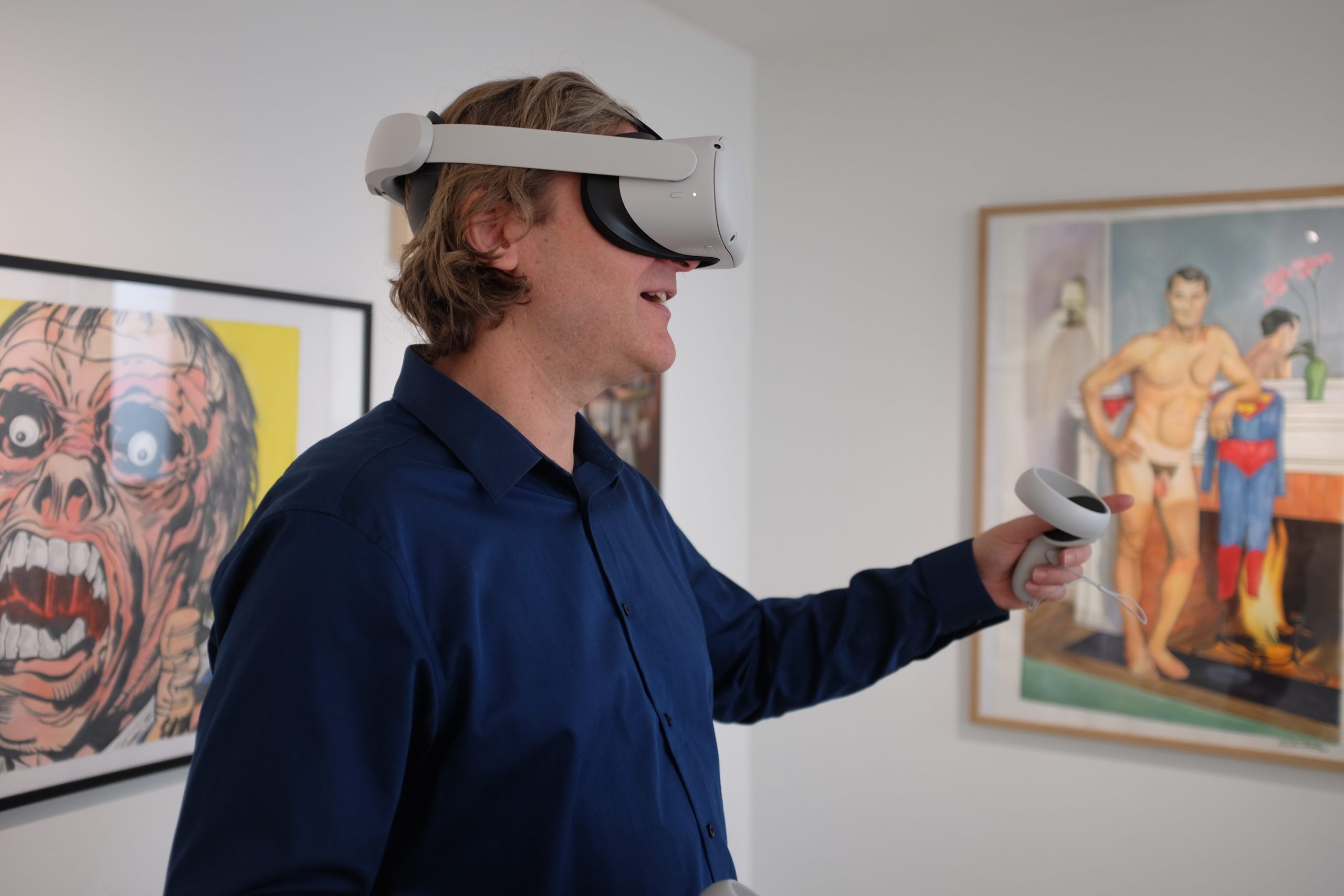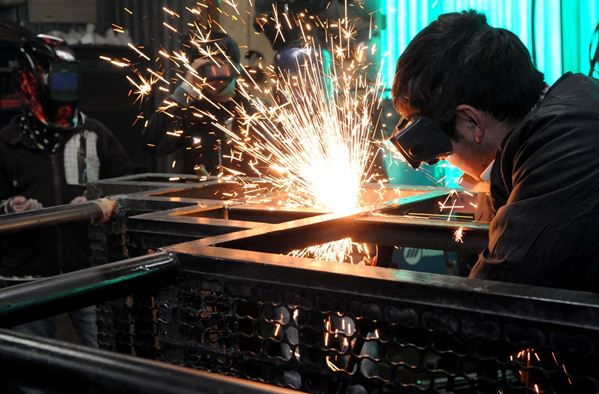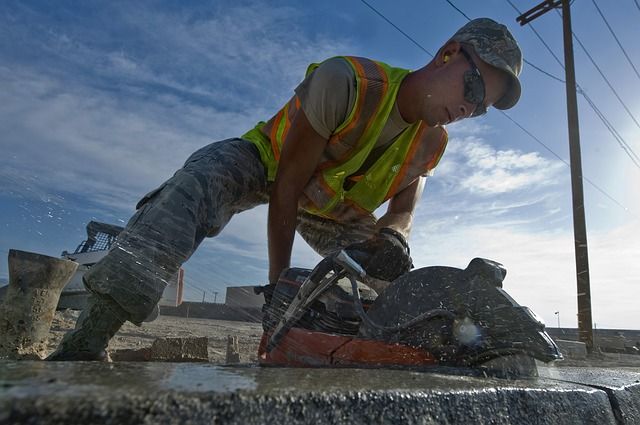Hunting the web and local art magazines, it’s difficult to glean what ‘Dead Star’, the latest exhibition by artist and gallery owner Eric Prince, entails.
It’s no accident: Prince has kept it a closely guarded surprise. Visitors will enter a blank-walled gallery with nothing but a wireless VR-headset – the Oculus Quest Two – in the centre of the room.
“Dead Star is a real-time, virtual reality art experience,” says Prince coyly.
Jacko laid bare
“People are going to see the advertisement for ‘Dead Star’ with an image of an actual dying star – like a star in the sky – but really you’ll see a dead floating human in front of you … and it’s Michael Jackson naked.”
The body is suspended, floating vertically “on the veil between life and death”, against a star-scape backdrop, with viewers free to approach and inspect it.
It’s something of a mic-drop moment as far as exhibition previews go. But shocking as the reveal may be, Dead Star is not a shock-value show.
“It’s a play on words and has a lot of poetry in it. Essentially, it’s about love and the lack thereof, drug abuse and addiction. There’s all kinds of death in art.”
And art in death, apparently. But if it’s not about shock, then why is he naked? “This is someone who has been overexposed by media coverage,” explains Prince. “People feel like they own this person. I’m making the viewerinto a ghoul.”
But wait, there’s more
Confronted with a dead, nude MJ, it might be easy to overlook the other feature on display. The platform running the VR – ArtXR – will be accessible during the show, ahead of its official launch.
ArtXR is a curated, digital gallery for artists to freely contribute to, and the computing is all real-time. “That means it’s being piped across the internet – there’s no download,” explains Prince, who built the platform himself using open-source technology.
“It’s exciting because it’s the future. This is real-time spatial computing.”
VR PR
That’s all very well, but why look at a painting through a headset rather than the real thing? For Eric the question misses the whole point of VR.
“You could say it’s much better in person. And I would agree! Except for if it’s a 3D piece of art like ‘Dead Star’, which will only ever exist in this medium. So real-time 3D art is a whole new genre.”
Accessibility is another major selling point: If you’re sick, disabled, unwilling to travel, or if a pandemic prevents you from going out, VR can bring experiences to you.
Of course, VR is bigger than art, as Prince recognises. “But I believe in art and culture. Art is a universal language: anyone can look at the Mona Lisa, or the Statue of David, and you don’t have to speak Italian to understand it. ArtXR can bring that experience to everyone in high fidelity.”
Helping artists get exposure
That’s what makes ArtXR unique – it’s one of the first, if not the first 3D platform of its kind specifically for artists.
For Prince, the platform’s potential to record the zeitgeist is particularly exciting: “We can also archive art using this software. We’re making the Alexandria library of the future – scanning and documenting a much more accurate depiction of what art movements are actually doing right now.”
But beyond exposure, exhibiting and archiving, ArtXR can also function as a trading platform for artists to sell their digital art.
Hold on, selling digital art?
That’s right. Maybe you’ve read about Grimes getting paid millions of dollars for NFTs, or that the founder of Twitter sold an autographed tweet as an NFT for close to 3 million dollars.
Perhaps you’re wondering: how can I, as an artist, get a piece of this pie?
When art is exhibited on ArtXR, it’s ‘tokenised’ – ‘turned into’ an NFT (non-fungible token). That means it’s registered on a type of database called a blockchain, which is a permanent, decentralised record.
An artist with a tokenised work on ArtXR has a ‘smart contract’ linking them to the art. If royalties are written into the contract, then when their work is sold as a digital object – even if it changes hands multiple times – they get paid.
“This technology is actually allowing artists to make a living!” laughs Prince, who suddenly seems every bit the painter and independent gallery owner, rather than the Silicon Valley hotshot.
“I think it’s going to add transparency to art sales – which is sorely needed. But it’s up to you if you want to sell work as an NFT on the platform. That’s the beauty of this: it is what you want it to be.”
Currency of the future
Another bonus: NFTs on ArtXR are minted on a green cryptocurrency called XDai – a so-called ‘stable coin’ whose value is tied to the US dollar, immunising it from the headline-grabbing fluctuations of Bitcoin and Etherium.
In plain English, to mint or create cryptocurrency, you need computing power – a lot of it. For example, in 2017, computing resources dedicated to mining Etherium used the same amount of energy as all of Iceland.
But XDai relies on newer technology that uses 1 percent of the energy of Etherium. While Etherium will take time to switch to a greener system, ArtXR is ahead of the curve. “We’re using the most ecologically affordable non-fungible token for our tokenised works,” says Prince.
In it for the long-haul
“Using a stable coin proves that we’re not in it for the short, speculative business side, we’re in it for the long-haul archival side,” he continues. “Business may be slower, but I don’t care. I know that this is the future.”
If it sounds, well, ground-breaking, it’s because it is. “I think ArtXR is one of the first in the world to marry the full immersive 3D experience with the blockchain system and NFT format for the purpose of exhibition, archiving and trading. I haven’t found anyone else doing exactly what we’re doing yet,” says Prince.
The next frontier
Of course, to experience it you still need a headset. So far, 1.87 million Oculus sets have been sold … small-fry in technology terms.
“It’s still early tech,” confirms Prince. “And my platform is an independent project. It’s still small.”
But ultimately the whole internet will shift over to 3D, so Prince doesn’t feel he’s competing with other platforms. “To me it’s simply let’s make the coolest technology possible,” he says.
Surprise!
So, that’s what visitors to ‘Dead Star’ can expect: the embryonic stage of the next whole information kick of humanity.
Talking to Prince is a bit like looking into a crystal ball. “When the iPhone is replaced with a pair of XR glasses, we’ll be sitting here with our little glasses on and I’ll go ‘Look at that picture right there’. You’ll look up and it’ll be a real-time digital effect.”
If the Prince Gallery show is anything to go by, that reality may not be as far off as you think.













